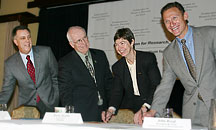

Four Institutions Announce Stem Cell Research Alliance
Four of the nation's preeminent research institutions, all based in San Diego, have announced their commitment to join forces in establishing an independent, non-profit consortium dedicated to stem cell research.
In a March 17 ceremony, The Burnham Institute for Medical Research, the Salk Institute for Biological Studies, The Scripps Research Institute, and the University of California, San Diego (UCSD) joined together to sign an agreement to pursue formal negotiations toward establishment and operation of an entity to be called the San Diego Consortium for Regenerative Medicine.
This historic alliance would marshal the intellectual resources of four world-leaders in life sciences research, bringing scientists from each institution together to develop and conduct joint research and training programs in one of today's most promising areas of science. Regenerative medicine references the ability of stem cells to proliferate and become specific cell types, giving them the therapeutic potential for repairing and replacing tissue damaged by disease or injury. The objectives of the San Diego Consortium for Regenerative Medicine include establishing a jointly operated facility dedicated to stem cell research, and pursuing funding to support these collaborative projects.
By forming this consortium, the partner institutions will unite in developing programs that build on the extraordinary strengths of the participants, creating a "super-collaboration" in an emerging area of research that has the potential to lead to greater understanding of disease, and ultimately to new therapies.
"One of the key factors that brought me to UCSD was the great potential of this university, with its location in the center of this world-renowned hotbed for science and discovery. Here, on the Torrey Pines Mesa, the spirit of collaboration flourishes," said Marye Anne Fox, chancellor of UC San Diego. "I believe strongly that this consortium will, in time, lead to significant scientific advances, and life-saving results in the form of new therapies and cures. In addition to the important research opportunities, the new avenues that will open up for education, training and translational medicine as a result of this consortium are exciting."
"We look forward to focusing particularly on applying our expertise in chemistry to the questions posed in stem cell research," said Douglas A. Bingham, executive vice president and chief operating officer at The Scripps Research Institute. "But we join in this endeavor not only to contribute what we know, but also to learn from our colleagues. The consortium itself is a significant experiment. We don't know what it will produce. But the combined knowledge, experience, and creativity of our respective researchers are sure to enlighten and surprise us all."
"For Salk scientists, the consortium provides the opportunity to work in stem cell research during the formative stages of this field, which is of enormous advantage," said Richard Murphy, president and CEO of the Salk Institute. "They will also benefit from the availability of shared core facilities and from the expertise of colleagues on the mesa working in research disciplines not represented at Salk. Conversely, Salk will bring to the consortium established stem cell experts as well as scientists whose work in gene expression and related fields is central to understanding how stem cells can be developed for therapeutic uses. Finally, the critical mass of expertise within the consortium will create new knowledge that today is totally unpredictable, which is the most exciting aspect of this initiative."
"At Burnham, our commitment to stem cell research is steadfast, and dates back to nine years ago when we formed a stem cell research division," said John Reed, president and CEO, Burnham Institute for Medical Research. "Though in its infancy, stem cell research promises to fundamentally change the course of history by providing cell replacement therapies for many debilitating and life-threatening diseases. As one of just six exploratory centers for human embryonic stem cell research, designated by the National Institutes of Health, we at Burnham are proud to join UCSD, Salk, and Scripps in a partnership to pool our resources and the talents of our scientists towards the goal of unlocking the mysteries of stem cell biology and devising the future therapies of regenerative medicine."
Serious discussions toward forming the consortium began as a result of the 2004 passage of the California Stem Cell Research and Cures Initiative (Proposition 71), which led to the formation of the California Institute for Regenerative Medicine (CIRM). The initiative allocated $3 billion in state funds to be managed by CIRM to support stem cell research in California. Up to $300 million of this funding can be allocated to build or lease facilities to house this research. Dissemination of funds has been prevented by lawsuits challenging the initiative, but major research centers throughout the state are gearing up to participate in this endeavor when the legal issues have been resolved.
San Diego is one of the most concentrated research and biotechnology clusters in the country, with a critical mass of resources located within a few square miles. This historic partnership will further position San Diego as an international hub for biomedical research and discovery leading to the development of new therapies and diagnostic and treatment technologies.
Over the next few months, the definitive details of the consortium will be finalized among the four institutions. When a four-party agreement to create the consortium is finalized, it will be presented for review and approval to the institutions' respective boards.
Links:
Send comments to: mikaono[at]scripps.edu

A March 17 ceremony celebrates the alliance among the San Diego institutions. Pictured here are (from left to right): Douglas Bingham of Scripps Research, Richard Murphy of Salk , Marye Anne Fox of UCSD, and John Reed of Burnham. Photo by Kevin Fung.
